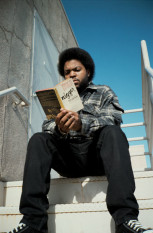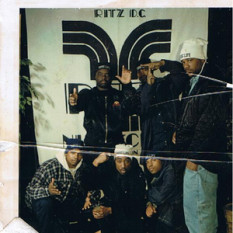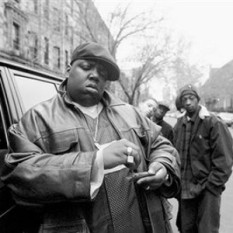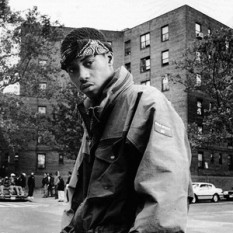Tupac Amaru Shakur (June 16, 1971–September 13, 1996), also known by his stage names, Makaveli and 2Pac, was an American hip-hop artist, poet and actor. He is listed in the Guinness Book of World Records as the best-selling rap/hip-hop artist ever, having sold over 75 million albums worldwide, including 44.5 million sales in the United States alone. He has had 17 top ten singles in the United States.
Born in East Harlem section of Manhattan in New York City, Tupac frequently found his family changing place of residence. In 1988, his family moved and brought Tupac and his half-sister Sekyiwa to live with a family friend in Marin City, California (In the Bay Area). He loved the state of California and decided thats where he would continue to reside for the rest of his life. Shakur soon moved in with a neighbor and started selling drugs and hustling on the street, but he also became interested in rap music. With Ray Luv and DJ Dize, he started a rap group called Strictly Dope. Their recordings were later released in 2001 under the name Tupac Shakur: The Lost Tapes. Their neighborhood performances brought Tupac enough acclaim to land an audition with Shock G of Digital Underground.
In 1990 he was hired as a back-up dancer for the alternative rap group Digital Underground. Tupac’s debut album, 2Pacalypse Now, gained critical recognition and a ranged amount of backlash for its controversial criticism of the police force. Shakur soon began to experience various law suits and legal troubles—most notably, he was convicted of sexually assaulting a woman in 1993. The day before the guilty verdict was issued, Shakur was shot five times in a recording studio lobby in Manhattan. Following the incident, Shakur grew suspicious that other rappers were involved in his shooting; the controversy would help spark the later East Coast-West Coast feud. After serving 8 months of his sentence for the assault, Shakur was bailed from prison by Marion “Suge” Knight, the CEO of Death Row Records. In exchange, Shakur would release three records under the label, with his fifth, being the double disc album All Eyez on Me counting as two albums. On September 7, 1996, Tupac was shot four times in a drive by shooting in Las Vegas, Nevada. On September 13, 1996, six days after the shooting, Tupac died of respiratory failure and cardiac arrest in a Las Vegas local hospital. Many posthumous albums have been released under Shakur’s name.
Tupac’s music addresses such topics as the hardships of growing up around violence in United States ghettos, poverty, racism, and his feuds with fellow rappers. He is known for the messages of political, economic, and racial equality that pervade his work as well as the “thug life” that he raps about living in. His music has attracted a large amount of controversy and was showcased in the media a number of times. He has gained a large amount of publicity for being one of the main figures in the East Coast vs. West Coast feud between his Death Row Records label and Bad Boy Records. During his lifetime, Tupac released five albums and played roles in several films.
Collaborations
2pac has done songs with many artists, especially L.A. and the Bay Area. Tupac was influenced by many artists in the Bay since he kicked it in Oakland, Ca and used to live in Marin City. The artists he hooked up with include; E-40, Richie Rich, Spice 1, Mac Mall, Ray Luv, Young Lay, Too Short, MC Breed, Assassin, Scarface, Dru Down, Funky Aztecs, B-Legit, Rappin 4-Tay, Method Man, Shock G, Money B, Dramacydal, Ice-T, Ice Cube, Snoop Dog, Dr. Dre, Treach (of Naughty By Nature), Kc & JoJo, C-Bo, Kurupt, Nate Dogg, Daz Dillinger, Bonethugs-N-Harmony, Redman and many more.
Early life
Tupac Amaru Shakur was born in the Harlem section of Manhattan in New York City. He was named after Túpac Amaru II, an Incan revolutionary who led a Peruvian uprising against Spain and was subsequently sentenced to death. His last name Shakur comes from the Arabic word thankful (to God). Fearing someone might hurt her son, Afeni put the name Parish Lesane Crooks on his birth certificate but changed it a year later. Shakur’s mother Afeni was an active member of the Black Panther Party in New York in the late 1960s and early 1970s; Shakur was born just one month after his mother’s acquittal on more than 100 charges of “conspiracy against the United States government and New York landmarks” in the “New York Panther 21” court case.
Shakur’s godfather, Elmer “Geronimo” Pratt, was convicted of murdering a schoolteacher during a 1968 robbery. His stepfather, Mutulu Shakur, spent four years at large on the FBI’s Ten Most Wanted Fugitives list beginning in 1982, when Tupac was a pre-teen. Mutulu was wanted in part for having aided his sister Assata Shakur, Tupac’s godmother, to escape from prison in New Jersey, where she had been incarcerated for the murder and wounding of two state troopers in 1973. Mutulu was caught in 1986 and imprisoned after being found guilty of the attempted robbery of a Brinks armored car in which two police officers and a guard were killed. Tupac has a half-sister, Sekyiwa, two years his junior, and an older step-brother, Mopreme “Komani” Shakur, who appeared on many of his recordings.
At age 12, Shakur was enrolled in Harlem’s famous “127th Street Ensemble”. His first major role with this acting troupe was as Travis in the play A Raisin in the Sun. In 1984, his family relocated to the Roland Park section of Baltimore. In that neighborhood he was not liked and was a social outcast because of his lack of trendy fashion, his name and looks. However, he had one friend there Dana “Mouse” Smith. In his sophomore year he transferred from Paul Lawrence Dunbar High School to the Baltimore School for the Arts, where he befriended a young Jada Pinkett. The two developed a close friendship. In the documentary Tupac: Resurrection, Shakur says, “Jada is my heart. She will be my friend for my whole life.” Also in this documentary, Smith calls Shakur “one of my best friends. He was like a brother. It was beyond friendship for us. The type of relationship we had, you only get that once in a lifetime.” In Tupac’s book, The Rose That Grew From Concrete, there is a poem written by Shakur titled “Jada” including another one titled “The Tears in Cupid’s Eyes” which is dedicated to her. The two remained close friends until Shakur’s death in 1996. At the School for the Arts, he studied ballet, poetry, jazz, and acting, performing in Shakespearean plays and landing the role of the Mouse King in The Nutcracker.
In June 1988, he and his family moved once again, this time to Marin City, California, where Shakur continued to pursue his career in entertainment. At the age of 17, he moved out of his mother’s house to seek his music career. In 1990 he was hired as a back-up dancer and roadie for up-and-coming rap group Digital Underground. His professional entertainment career began in early 1991, when he debuted his rap skills on the single “Same Song” from the group’s album This is an EP Release. Also in 1991, he appeared in the music video for “Same Song” and made a brief appearance as himself in the movie Nothing But Trouble.
Rise to fame
In late 1991, after his rap debut, Tupac Shakur performed with Digital Underground again on the album Sons Of The P. Later that year, he released his first solo album, 2Pacalypse Now. Initially he had trouble marketing his solo debut, but Interscope Records executives Ted Field and Tom Whalley eventually agreed to distribute the record.
Shakur claimed his first album was aimed at the problems facing young black males, but it was publicly criticized for its graphic language and images of violence by and against police. In one incident, a young man claimed his killing of a Texas trooper was inspired by the album. Former Vice President Dan Quayle publicly denounced the album as having “no place in our society”. 2Pacalypse Now did not do as well on the charts as future albums, spawning no top ten hits, and only being certified gold nearly 4 years later. His second album, Strictly 4 My N.I.G.G.A.Z., was released in 1993. Heavily produced by Stretch and the Live Squad, the album generated two hits, Keep Ya Head Up and I Get Around, the latter featuring guest appearances by other members of the Digital Underground crew.
In addition to rapping, Shakur began acting in films. His first starring role was in the 1991 movie Juice, in which he was hailed by Rolling Stone’s Peter Travers as “the film’s most magnetic figure.” He went on to star in Poetic Justice (with Janet Jackson), Above the Rim, Gridlock’d (with Tim Roth), Bullet, and Gang Related. He had also been slated to star in the Hughes brothers’ Menace II Society but was replaced by Larenz Tate after assaulting the directors. Director John Singleton claimed that he wrote the film Baby Boy with Shakur in mind for the leading role. It was eventually filmed with Tyrese Gibson in his place and released in 2001, five years after Shakur’s death. The movie features a mural of Shakur in the protagonist’s bedroom as well as featuring one of his songs.
In late 1993, Shakur formed the group Thug Life with a few of his friends, including Big Syke, Macadoshis, his step-brother Mopreme, and Rated R. The group released their first and only album Thug Life: Thug Life Vol. 1 on Interscope in 1994 which went on to be certified as a gold record.
Legal issues
Even as he garnered fame as a rapper and actor, Shakur gained notoriety for his conflicts with the law. On October of 1991 he filed a $10 million lawsuit against the Oakland Police Department, alleging they brutally beat him over a jaywalking incident. The suit was later settled for $42,000.
In October 1993, in Atlanta, Shakur shot two off-duty police officers (one in the leg, one in the buttocks) that were harassing a black motorist. Charges against Shakur were dismissed when it was discovered that both officers were intoxicated and were in possession of stolen weapons from an evidence locker during the incident.
In December 1993, however, Shakur was charged with sexually abusing a woman in his hotel room. According to the complaint, Shakur sodomized the woman and then encouraged his friends to sexually abuse her. Shakur vehemently denied the charges. Tupac had prior relations days earlier with the woman who was pressing the charges against him. She had performed oral sex on him on a club dance floor and the two had later had sex in his hotel room. The allegations were made after she revisited his hotel room for the second time where she engaged in sexual activity with his friends and claimed Tupac’s entourage had gang-raped her, saying to him while leaving, “How could you do this to me?” Tupac states he had fallen asleep shortly after she arrived and later awoke to her accusations and legal threats. He later said he felt guilty for letting anything occur in the first place, and did not want anyone else to go to jail, but at the same time did not want to go to jail for a crime he didn’t commit. On February 7, 1995, he was sentenced to four and a half years in prison for sexual assault; specifically, the conviction offense was for “sexual abuse (forcibly touching the buttocks).”
In 1994, he was convicted of attacking a former employer while on a music video set. He was sentenced to 15 days in jail with additional days on a highway work crew, community service, and a $2000 fine. In 1995, a wrongful death lawsuit was brought against Shakur in the 1992 shooting of 6-year old Qa’id Walker-Teal of Marin City, CA. The child had been the victim of a stray bullet in a shootout between Tupac’s entourage and a rival group, though the bullet was not from Tupac’s gun. Criminal charges were not sought, and Shakur settled with the family for an amount estimated between $300,000 and $500,000. After serving part of his sentence on the sexual abuse conviction, he was released on bail pending his appeal. On April 5, 1996, a judge sentenced him to serve 120 days in jail for violating terms of probation.
The November 30, 1994 Shooting
On the night of November 30, 1994, the day before the verdict in his sexual abuse trial was to be announced, Shakur was shot five times in the lobby of the Quad Recording Studios in Manhattan by two black men in an apparent robbery attempt. He would later accuse Puff Daddy (now Diddy) and Notorious B.I.G. whom he saw after the shooting of setting him up. Shakur believed that Biggie and Puffy knew about the plans of the shooting beforehand but had not warned Shakur ahead of time. According to the doctors at Bellevue Hospital, where he was admitted immediately following the incident, Shakur was shot 5 times. He checked out of the hospital, against doctor’s orders, three hours after surgery. The day following the incident, December 1, 1994, Shakur entered the courthouse in a wheelchair and was found guilty of forcibly touching her buttocks.
Prison sentence
Shakur began serving his prison sentence at Clinton Correctional Facility in February 1995. Shortly afterwards, he released his multi-platinum album Me Against the World. Shakur is the only artist ever to have an album at number one on the charts while serving a prison sentence. He married his long-time girlfriend, Keisha Morris, while serving his sentence. This marriage was later annulled. He also spent time reading the works of Niccolò Machiavelli (which inspired his later use of the name “Makaveli”), Sun Tzu’s The Art of War and other works of political philosophy and strategy. He also wrote a screenplay titled Live 2 Tell while incarcerated.
In September 1995, Shakur was released on bail after serving 11 months of his 4 year sentence, due in large part to the help and influence of Marion “Suge” Knight, CEO of Death Row Records. Knight posted $1.4 million bail pending appeal of the conviction, in exchange for which Shakur was obligated to release three albums for the Death Row label.
Post-prison/Death Row Records
After his release from prison, Shakur immediately went back to work recording. He began a new group, Tha Outlawz, and with them released the notorious diss track “Hit ‘Em Up”, a scathing lyrical attack on the Notorious B.I.G (Christopher Wallace) and others associated with him. In the track, Shakur claims to have had sex with Faith Evans, Wallace’s wife at the time, and attacks his street cred. Though there is no hard evidence suggesting that they did, Tupac was convinced that Wallace and Sean “Puffy” Combs had known about the shooting beforehand based on their behavior that night and what his sources told him. He also believed that the lyrics in Biggie’s track “Who Shot Ya” were disrespectful and shouldn’t have been released at such a time.
Shakur aligned himself with Death Row Records CEO Suge Knight, who was already bitter toward Combs and his successful Bad Boy label; this added fuel to the building East-West feud. Wallace and Shakur would remain bitter enemies until Shakur’s death.
In February 1996, Shakur released his fourth solo album, All Eyez on Me. This double album was the first and second of his three-album commitment to Death Row Records. It sold over 9 million copies. The album was a general departure from the introspective subject matter of Me Against the World, being more oriented toward a thug and gangsta mentality. Shakur continued his recordings despite increasing problems at the Death Row label. Dr. Dre left his post as house producer to form his own label, Aftermath. CEO Suge Knight was under investigation for illegal and unethical activities and business practices. Despite these problems, Shakur produced hundreds of tracks during his time at Death Row, most of which would be released on posthumous albums such as Better Dayz and Until the End of Time. He also began the process of recording an album with the Boot Camp Clik and their label Duck Down Records, both New York-based, entitled One Nation. The goal of this project was to bring closure to the East Coast-West Coast feud by bringing together what Shakur thought were the best rappers from both coasts. This project remains unreleased, though some of Tupac’s contributions to the album have been used in various other posthumous releases.
By the end of his life, Tupac was in the middle of starting his film production company Euphanasia, and was going to start writing and directing films. Tupac wanted to host concerts that would be free for students who get a C or above, and wanted to build community centers and start baseball and football leagues for inner-city children. Tupac and Johnny “J” were starting up 24/7 Productions and Tupac was starting up Non-Stop Productions. Thug Passion was a drink that Tupac was planning on bottling and selling; the song “Thug Passion” was made to be a theme song for the drink. Tupac was going to step back from rapping by releasing albums every five years or so on his new record label, Makaveli Records, which would have been distributed by Death Row Records. Tupac and Suge Knight were in the process of expanding Death Row to the East, establishing a Death Row East. Tupac died before this could be fulfilled.
The Fatal September 7, 1996 shooting
On September 7, 1996, Shakur attended the Mike Tyson-Bruce Seldon boxing match at the MGM Grand in Las Vegas, NV. After the boxing match, Shakur spotted 21 year-old Orlando “Baby Lane” Anderson, a member of the Southside Crips in the MGM Grand lobby. Shakur rushed him and knocked Anderson down, and Shakur’s entourage beat him. The incident was captured on the hotel’s video surveillance. Anderson had allegedly beaten up one of Shakur’s bodyguards in a shopping mall a few weeks earlier, precipitating Shakur’s attack. After the fight with Anderson, Shakur met up with Suge Knight to go to Death Row-owned Club 662 (now known as restaurant/club Seven). Shakur rode with Knight in Knight’s 1996 black BMW 750i sedan, as part of a larger convoy of cars including some of Shakur’s friends, tha Outlawz, and bodyguards.
At 11:14 P.M., while stopped at the intersection of East Flamingo Road and Koval Lane, Shakur was shot in a drive-by shooting. Shakur was hit four times, twice in the chest, and once each in his arm and thigh, while Knight was scratched in the head by a piece of flying glass.
At the time of the shooting, Shakur was riding alongside with Suge Knight, with his bodyguard following behind in a vehicle belonging to Kidada Jones, Shakur’s then-girlfriend. The bodyguard, Frank Alexander, stated that while he was about to ride along with the rapper in Suge Knight’s car, Shakur asked him to drive Kidada Jones’ car in case they were too drunk and needed additional vehicles from Club 662 back to the hotel. Shortly after the shootings, the bodyguard reported in his documentary, Before I Wake, that one of the convoy’s car drove off after the assailant but he never heard back from the occupants.
After arriving on the scene, police and paramedics took Shakur and Knight to the University Medical Center. Shakur was placed on life support until his death six days later, on September 13, 1996, at 4:03 PM. He was 25 years old. The official cause of death was respiratory failure and cardiac arrest. After his death, Shakur’s body was cremated. Family and friends reportedly spread his ashes over the Pacific Ocean near Los Angeles, CA.
Theories of the crime
Although no one has ever been formally charged, nor publicly identified by the police as a suspect, police sources have indicated they believe that Anderson (who has since been murdered himself) and his fellow Southside Crips were behind the shooting. Officers in the Compton, CA Police Department Gang Unit claimed the Crips were bragging about the killing soon after Anderson returned from Las Vegas. Officers further indicated they were disappointed with the lack of initiative shown by the Las Vegas Police Department in pursuing Shakur’s killer(s).
Due largely to the perceived l...
All albums
You can find information through the best music search engine - Muzlan.top 😊All materials on request "2Pac" are available on page 2Pac
Yes of course. You can listen tracks on the page 2Pac
Yes of course. You can download tracks on the page 2Pac
This page is found by queries: 2Pac remix, 2Pac track minus, 2Pac all mp3, 2Pac flac, 2Pac song download




